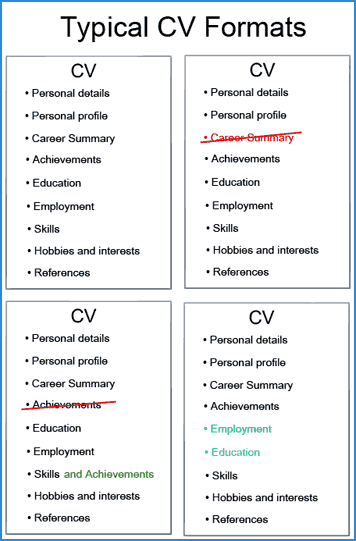 Sobhan Mohmand, Career Expert
Sobhan Mohmand, Career Expert  3 May 2021
3 May 2021
A typical CV format consists of the following eight sections:
It is very important to get this CV structure correct.
All CVs differ from each other slightly in the ordering of the sections, however, the thing that does stay the same is roughly the inclusion of the information listed above.
It is not possible to have a CV which hasn’t got a personal information section at the top.
In the same way, it is not possible to be in your late 40s and not have a work experience section on your CV!
That is an excellent question!
The following are the circumstances in which your CV format might change:
It is not uncommon to see the education section and work experience section of a CV being swapped around depending on the type of job applied for…
Some job vacancies put a lot of emphasis on formal education and therefore the format of your CV should accommodate this and place the education section before your work experience.
In other cases; you might have excellent work experience but a poor education, in which case your work experience section will come before your education section.
Your age, background and current circumstances might affect the format of your CV.
For example, if you’re still in school and are looking for your first job, you may want to skip the work experience section from your CV and put a lot of focus on your skills and education.
To summarise, although there is such a thing as a ‘typical CV format’ this does not mean that all CVs will have exactly the same formatting. The CV format will change depending on the job you are applying for and where you are in your career so far.

Note:
The layout and presentation of your CV is a critical part of writing a perfect CV which will result in getting into interviews. You may have the best education, work experience and skills but if your CV layout and presentation is not professional and well-presented, then your CV is most likely going into the bin.
With this in mind, let’s look at CV layouts…
The layout of any CV falls under two different categories:
The content layout refers to the different sections and information a typical CV consists of, which are shown and listed above.
As discussed, the layout of the CV’s content can be slightly different depending on the applicant, but in the majority of cases, even the layout of the sections are identical.
The visual layout, on the other hand, concentrates more on the appearance and presentation of the CV’s content and information. The following are some of the areas that can have a major impact on a CVs visual presentation:
Summary
Even though no two CVs are exactly the same; there is a standard CV format which all the job seekers are advised to follow. Any major deviations from this typical CV layout can alienate potential employers and as a result, render the job application unsuccessful.